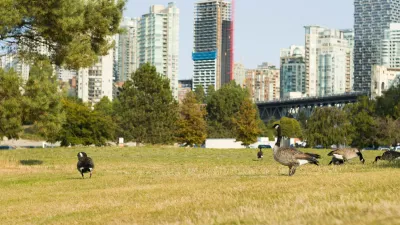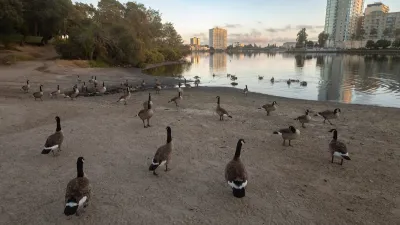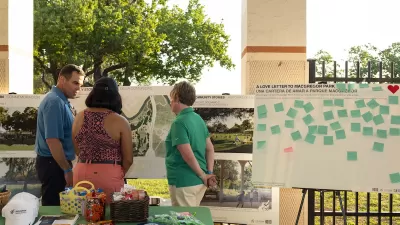Looking to escape the hustle and bustle of the city in your neighborhood park? For a true mental vacation, head for the park with the densest vegetation, writes Eric Jaffe.
Following up on a recent piece on the restorative powers of parks, Jaffe revisits the topic with new research in hand that gets at the question of "precisely how many trees it takes to recover the cognitive strains of urban life."
According to an article appearing in an upcoming issue of the journal Landscape and Urban Planning, a group of Finnish researchers found that, "perceived restorativeness in urban forests was strongly affected by
closure of view to the urban matrix through the forest vegetation. This
means that perceived restorativeness was higher inside the forest with a
closed (i.e. no) view to the urban matrix as compared to semi-closed
and open views."
"The most intriguing conclusion to be drawn here is that the size of an
urban park isn't nearly as important as the density of its vegetatio," writes Jaffe.
"Even when a nature site borders an urban road or housing development, it
can function as a restorative place so long as it offers easy access to
a dense interior. In other words, the ultimate goal is not to see the
city for the trees," he concludes.
FULL STORY: How Urban Parks Enhance Your Brain, Part 2

Planetizen Federal Action Tracker
A weekly monitor of how Trump’s orders and actions are impacting planners and planning in America.

Restaurant Patios Were a Pandemic Win — Why Were They so Hard to Keep?
Social distancing requirements and changes in travel patterns prompted cities to pilot new uses for street and sidewalk space. Then it got complicated.

Maui's Vacation Rental Debate Turns Ugly
Verbal attacks, misinformation campaigns and fistfights plague a high-stakes debate to convert thousands of vacation rentals into long-term housing.

In California Battle of Housing vs. Environment, Housing Just Won
A new state law significantly limits the power of CEQA, an environmental review law that served as a powerful tool for blocking new development.

Boulder Eliminates Parking Minimums Citywide
Officials estimate the cost of building a single underground parking space at up to $100,000.

Orange County, Florida Adopts Largest US “Sprawl Repair” Code
The ‘Orange Code’ seeks to rectify decades of sprawl-inducing, car-oriented development.
Urban Design for Planners 1: Software Tools
This six-course series explores essential urban design concepts using open source software and equips planners with the tools they need to participate fully in the urban design process.
Planning for Universal Design
Learn the tools for implementing Universal Design in planning regulations.
Heyer Gruel & Associates PA
JM Goldson LLC
Custer County Colorado
City of Camden Redevelopment Agency
City of Astoria
Transportation Research & Education Center (TREC) at Portland State University
Jefferson Parish Government
Camden Redevelopment Agency
City of Claremont





























